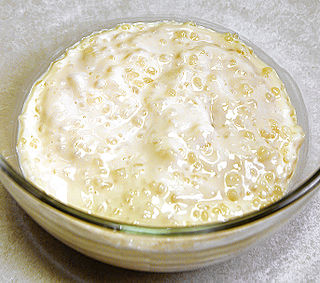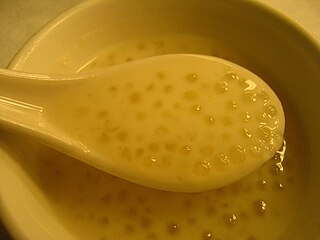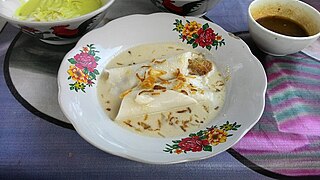
Hong dou tang is a popular Chinese dish served in Mainland China, and Taiwan. It is categorized as a tang shui 糖水 or sweet soup. It is often served cold during the summer, and hot in the winter. Leftover red bean soup can also be frozen to make ice pops and is a popular dessert. A similar dessert 紅豆沙 in Hong Kong is commonly mistaken by people outside Hong Kong as the same dessert, of which the latter one has a very different texture.

A coulis is a form of thin sauce made from puréed and strained vegetables or fruits. A vegetable coulis is commonly used on meat and vegetable dishes, and it can also be used as a base for soups or other sauces. Fruit coulis are most often used on desserts. Raspberry coulis, for example, is especially popular with poached apples or Key lime pie.

Tapioca pudding is a sweet pudding made with tapioca and either milk or cream. Coconut milk is also used in cases in which the flavor is preferred or in areas in which it is a commonplace ingredient for cooking. It is made in many cultures with equally varying styles, and may be produced in a variety of ways. Its consistency ranges from thin (runny), to thick, to firm enough to eat with a fork.

Peranakan cuisine or Nyonya cuisine comes from the Peranakans, descendants of early Chinese migrants who settled in Penang, Malacca, Singapore and Indonesia, inter-marrying with local Malays. In Baba Malay, a female Peranakan is known as a nonya, and a male Peranakan is known as a baba. The cuisine combines Chinese, Malay, Javanese, South Indian, and other influences.
Krentjebrij is a Groningen/north Drenthe name for a traditional soup or porridge-like dessert with juice of berries that is eaten either warm or cold. It is also known as watergruel or krintsjebrij in Friesland. While there is no exact English translation for the word Krentjebrij, it could be called Raisin Porridge, Berry Soup, Berry Gruel, or a literal translation could be "currants cooked to mush". A commercially available product called Bessola is made in the Netherlands.
Common Ingredients:
Traditional Estonian cuisine has substantially been based on meat and potatoes, and on fish in coastal and lakeside areas, but now bears influence from many other cuisines, including a variety of international foods and dishes, with a number of contributions from the traditions of nearby countries. Scandinavian, German, Russian, Latvian, Lithuanian and other influences have played their part. The most typical foods in Estonia have been rye bread, pork, potatoes and dairy products. Estonian eating habits have historically been closely linked to the seasons. In terms of staples, Estonia belongs firmly to the beer, vodka, rye bread and pork "belt" of Europe.

Binignit is a Visayan dessert soup from the central Philippines. The dish is traditionally made with glutinous rice cooked in coconut milk with various slices of sabá bananas, taro, and sweet potato, among other ingredients. It is comparable to various dessert guinataán dishes found in other regions such as bilo-bilo. Among the Visayan people, the dish is traditionally served during Good Friday of Holy Week.

Rødgrød, rote Grütze, or rode Grütt, meaning "red groats", is a sweet fruit dish from Denmark and Northern Germany. The name of the dish in Danish features many of the elements that make Danish pronunciation difficult for non-native speakers, so rødgrød med fløde, literally "red porridge with cream", is a commonly used shibboleth since the early 1900s.

Sundanese cuisine is the cuisine of the Sundanese people of Western Java, and Banten, Indonesia. It is one of the most popular foods in Indonesia. Sundanese food is characterised by its freshness; the famous lalab eaten with sambal and also karedok demonstrate the Sundanese fondness for fresh raw vegetables. Unlike the rich and spicy taste, infused with coconut milk and curry of Minangkabau cuisine, the Sundanese cuisine displays the simple and clear taste; ranged from savoury salty, fresh sourness, mild sweetness, to hot and spicy.

Sago soup or Sai mai lou is a type of tong sui dessert in Cantonese cuisine, which is also a variant of tapioca pudding. It is basically made by pearl tapioca (sago), coconut milk and evaporated milk. The dish is traditionally prepared using sago starch, which is derived from sago palm pith. Other ingredients can also be added, such as taro, pumpkin, mango, etc.
Fruktsoppa is a fruit soup that is typically prepared using dried fruits, and usually served as a dessert dish. The dish has been described as a "cold fruit pudding." It is a traditional dessert in Sweden and Norway. Historically, during the winter months in Scandinavian countries, fresh fruit was generally unavailable, so people used dried fruits for the preparation of various dishes, including fruktsoppa. The soup may be served hot or cold. The soup can be made with one fruit or with multiple fruits; a soup which is made with multiple fruits may be called blandad fruktsoppa, which is Swedish for "mixed fruit soup".

Pastor Hans Møller Gasmann was a Norwegian educator from Oslo, promoter of association football and one of Norway's first Scout leaders, who founded the Second Christiania Scout Troop at Frogner in Oslo in 1910. In spring 1911, he met with Christian Dons, who had started the First Christiania Scout Troop. They founded the Norwegian Guide and Scout Association.
Coconut soup is a fruit soup prepared using coconut milk or coconut fruit as a main ingredient. Many varieties of coconut soups exist in the world, including ginataan, laksa, sayur lodeh, soto, and tom kha kai, and myriad ingredients are used. They can be served hot or cold. While most coconut soups are savoury dishes, some varieties—such as binignit and kolak—are sweet dessert soups.

Sarawakian cuisine is a regional cuisine of Malaysia. Like the rest of Malaysian cuisine, Sarawak food is based on staples such as rice. There is also a great variety of other ingredients and food preparations due to the influence of the state's varied geography and indigenous cultures quite distinct from the regional cuisines of the Peninsular Malaysia. Sarawak is famous for its multi-ethnic population. As the homeland of many unique communities, Sarawak has a variety of cuisines rarely found elsewhere in Malaysia. The uniqueness of Sarawak well depends on its ethnic groups. Every native group in Sarawak has their own lifestyle, traditions, cultures and also foods. Sarawak cuisine is less spicy and has a subtle in taste. It uses fresh seafood and natural herbs like turmeric, lemongrass, ginger, lime and tapioca leaves. These ingredients are not only easily available, but also add a hint of aroma, texture and freshness to the delicacies. Food is one of the most cultural identities for native groups in Sarawak with each ethnic group having their own delicacies. Among the Iban, popular foods include tubu (stems), tuak and pansuh. The Malay have bubur pedas (porridge) and kek lapis Sarawak ; the Bidayuh have asam siok and sup ponas Bidayuh. The Melanau make tebaloi, sagu and umai and the Orang Ulu are known for garam barrio, kikid (broth), tengayen, and urum giruq (pudding).

Burgo is an Indonesian folded rice pancake served in savoury whitish coconut milk-based soup, flavoured with fish, and sprinkled with fried shallots. The dish is one of the regional specialty of Palembang, the capital of South Sumatra, Indonesia. In Palembang, burgo is a popular choice for breakfast. Burgo is quite similar with lakso, although lakso is thick rice noodles and its soup has yellowish color acquired from turmeric.

Samalamig, also known as palamig, refers to various traditional Filipino sweet chilled beverages that usually include jelly-like ingredients. They can come in various flavors. They are commonly sold by street vendors as refreshments. Typical ingredients of the drinks include gulaman (agar), sago pearls, kaong, tapioca pearls, nata de coco, and coconut. They are usually anglicized as pearl coolers or pearl and jelly coolers.

Sagu is a southern Brazilian dessert, made with tapioca pearls, sugar and red wine. It is typical of the state of Rio Grande do Sul, but also consumed in Santa Catarina and Paraná.













